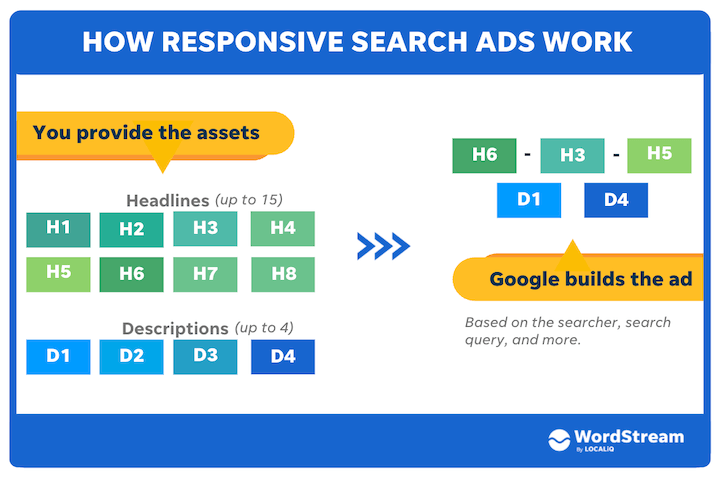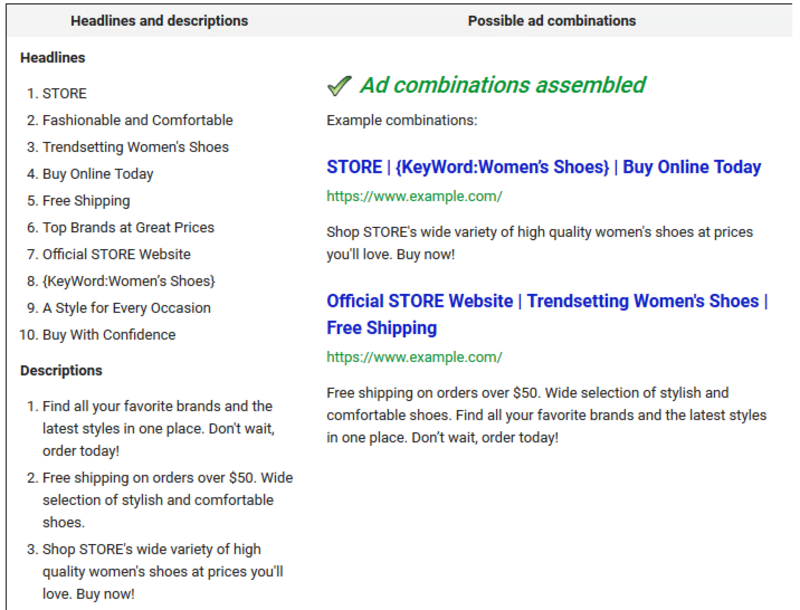
Anyone who’s worked in search marketing has had a moment when they feel like they’ve really nailed the perfect ad for their product or service. Witty headline? Check! Compelling call to action? Check! Keyword/ad text pairing on point? Check! As the data sets in, we’re of course sometimes right and sometimes wrong, but we still feel that sense of pride in the fact that text ads can be, in some small way, little works of art.
I think this point of pride in part explains some of the skepticism that some search marketers have expressed concerning Google’s Responsive Search Ads (RSAs), which are made in an entirely different way. In this post, I’m going to tell you everything you need to know about responsive search ads. We’ll cover:
- How responsive search ads work.
- The benefits of responsive search ads.
- Five ways you can use RSAs to maximize your ROI.
Note: This information is more important than ever since RSAs will be the only dynamic search ad type you can create after June 30, 2022. Learn more tips here!
How do responsive search ads work?
Instead of crafting a “perfect” ad and setting it loose on Google for testing, RSAs are essentially an ad assembly kit. The advertiser provides all the “parts” of the ad (2-15 headlines and 2-4 descriptions); Google then picks and arranges how the pieces come together. This arranging is carried out on an auction-by-auction basis, where the ads are assembled on the fly to match your audience’s specific search query and search history, and also presumably other proprietary user-specific data that Google’s machine learning algorithms may use to anticipate conditions that will encourage a click—and hopefully, a conversion, to happen.
What are the benefits of responsive search ads?
Herein lies the strength of the responsive search ad format. While “standard” search ads fit a core set of sensibilities and drives, they appeal to you, or your imagined audience. RSAs, on the other hand, can potentially reach a much larger audience, in a way that still appeals to their needs and values. And the results can be fantastic: In a head-to-head matchup that I ran from January 1 – May 31st across 500 accounts, RSAs earned 243% more impressions per ad and had a 5% better conversion rate.
Think of this grouping of assets as a “battle royale” that takes place in each auction event, letting the headline/description combination that best pairs the search query with the keywords to get an edge in ad rank that can make your ad more likely to appear to a user.
But RSAs can be pretty useless, or even counterproductive, if you simply throw a bunch of recycled content into them and call it a day. Without paying careful attention to how responsive ads are designed to home in on the particular needs of a wide range of people, you can wind up with a mix of assets that can’t possibly blend together to create a compelling ad. When that happens, you’re really just doing yourself a disservice.
Meanwhile, crafting RSAs need not necessarily be an artless and joyless exercise; in fact, when one considers some strategies for crafting responsive ads that work, they can be an art in their own right.
How to use responsive search ads to maximize your ROI
To get the most out of your RSA campaigns, it’s important to pay attention to the details. Even though you’re aiming for a wider reach, you need to put careful thought into your ad copy so that it remains versatile while also maintaining efficacy for each variation. Use these five strategies below to ensure you come up with top notch RSA campaigns, reap all of the benefits RSAs have to offer, and get an accurate picture of your performance.
Find out even more ways to maximize your Google Ads ROI with our Free Google Ads Performance Grader!
1. Address a variety of searchers
No matter how niche your product or service is, your audience has a wide range of interests and affinities, and their interests will be piqued by different things. Some folks are value shoppers; others are thinking primarily about quality; still others might be thinking about how quickly they can get what they’re looking for, or whether the materials used in the product they are looking for are ethically sourced. And of course, most people have a couple interests in mind at any given time.
No single ad can speak to all of these needs; however, a single responsive search ad can lay the groundwork for meeting all of these potential users by incorporating assets (in the form of distinct headlines and description lines) that speak to all of these interests and affinities. In order to make sure this groundwork is laid, I suggest doing some thinking about several different kinds of people who you’re trying to get to your landing page (let’s call them customer A, B, and C), their distinct needs and values, and write out the best headlines that would answer the following questions for each prospective customer:
- What is the product or service you’re promoting?
- What are key selling points of your product or service?
- What calls to action will be most appealing?
- Are there any unique options, prices, promotions or discounts for your searcher?
If you have these questions answered for each of your three prospective customers, you’ll have 12 of your 15 maximum headlines taken care of.
2. Bring diversity to your ad copy
Addressing a wide range of needs also means avoiding redundancy. So don’t fill your suite of headlines with calls to action that would be nonsensical if paired up:
The above example ad is exactly what happens when you take materials from three good standard ads and dump all the headlines into a responsive search ad. When we write great standard ads, we naturally think a lot about how the ordering of our headlines and description affects the persuasiveness of our ads. So in a standard ad, a call to action might organically follow something that’s more explanatory. But if all of the variants of the same call to action appear together with no other context, the result is just silly.
Instead, think about how your ad copy can complement other headlines and description line by having distinct, valuable things to say. Perhaps the trickiest aspect of crafting the responsive search ad involves creating copy that can work independently of the other ad units (you can’t take for granted that any two pieces of ad copy will be in the mix), but once you have this ironed out, you have accomplished your goal of truly providing Google with a blueprint for many different ads that can reach a multitude of users.
If you are really committed to having one specific headline or description line show up in all instances of your ad’s appearance, you can use the “pin” option for the RSAs to set a certain headline or description line in a specific position and leave other parts of the ad open for swapping. If you do so, though, I do encourage you to add another fully responsive ad to the ad group so that you can compare performance.
For more help with this, use our handy dandy responsive search ad copy template.
3. Let Google’s ad strength tool be your guide
In addition to providing your own common sense to the ad creation process, you can also leverage Google’s ad strength tool to gauge how well Google “thinks” your ad is. Simply select “edit” on any RSA in Google Ads and you will be able to see Google’s “rating” of your ad.
The tool gauges strength based on several factors, including the number of headlines and descriptions used, the variety of words used & keyword relevance. It will even provide suggested additions based on your other ad assets (extensions, standard ads, and more). While the tool isn’t necessarily the best judge of how persuasive a particular headline or description field might be, it can help get you thinking about new paths to take in your ad making.
4. Adjust your KPIs for increased impressions
Of course, the best gauge of how good your RSAs are is the outcome. If your responsive ads are successful in producing combinations that match with more queries and users than traditional ads, it’s likely that your ads will reach a wider audience and thus get more impressions than you’ve seen with a single standard ad.
When this happens, you (or your clients) may have to rethink certain KPIs, especially click-through-rates (CTR). For example, in my recent study comparing RSA and standard text ad performance, I found that RSAs had 283% more impressions per ad than the standard ads—they quite simply blew the number of ads out of the water when it came to reaching new people.
At the same time, because more people were seeing the ads, the CTR went down 5%. In the long run, however, the lower CTR meant little in the face of the fact that the clicks that I did get were of better quality: since they had a better conversion rate on clicks, they ultimately drove more conversions to my campaigns than the traditional ads and thus got my clients better results.
5. Use the best combinations to make new standard ads
Even as you craft the best responsive search ads that you can, it is not recommended that you simply abandon your old ad copy. You may already have some very effective headline and description pairings that you know work terrific in a particular order and only that order. Such ads may continue to be some of your best assets for reaching the audience they were tailored for, but having responsive ads sit side-by-side in the same ad group pays off in the long run.
Since responsive ads help to broaden that audience by better matching queries that might not best match your standard copy, they provide a powerful supplement to your strongest ads. Moreover, by keeping your tried and true copy in the same ad group as the responsive search ads, you can compare performance and further optimize based upon the results you see.
In fact, it may be best to think of your RSA data as a laboratory for helping you come up with the best possible ad copy arrangements. In one account, I found that an RSA variation of one of my long-running expanded text ads was getting tons of engagement when it reversed the typical ordering of my headlines and used a different description line. This then led me to create a standard “expanded” text ad mimicking the combination, which led to more engagements.
Start using RSAs for better ROI
By now, I’ve hopefully persuaded you that you ought to try responsive search ads, if you haven’t done so already. If trying them out still seems a bit intimidating, I suggest checking out Google’s growing library of resources concerning RSAs, including video tutorials and their own best practices guide. They also unpack key technical details in an overview page on the ad format.
About the author
Ty Alyea is Director of Search Marketing Product at Service Direct, where he is responsible for creating and managing thousands of digital ad campaigns across hundreds of local service industries for 1,000+ clients across North America. He has a B.A. from UCLA as well as an M.A. and PhD from the University of Texas at Austin.














